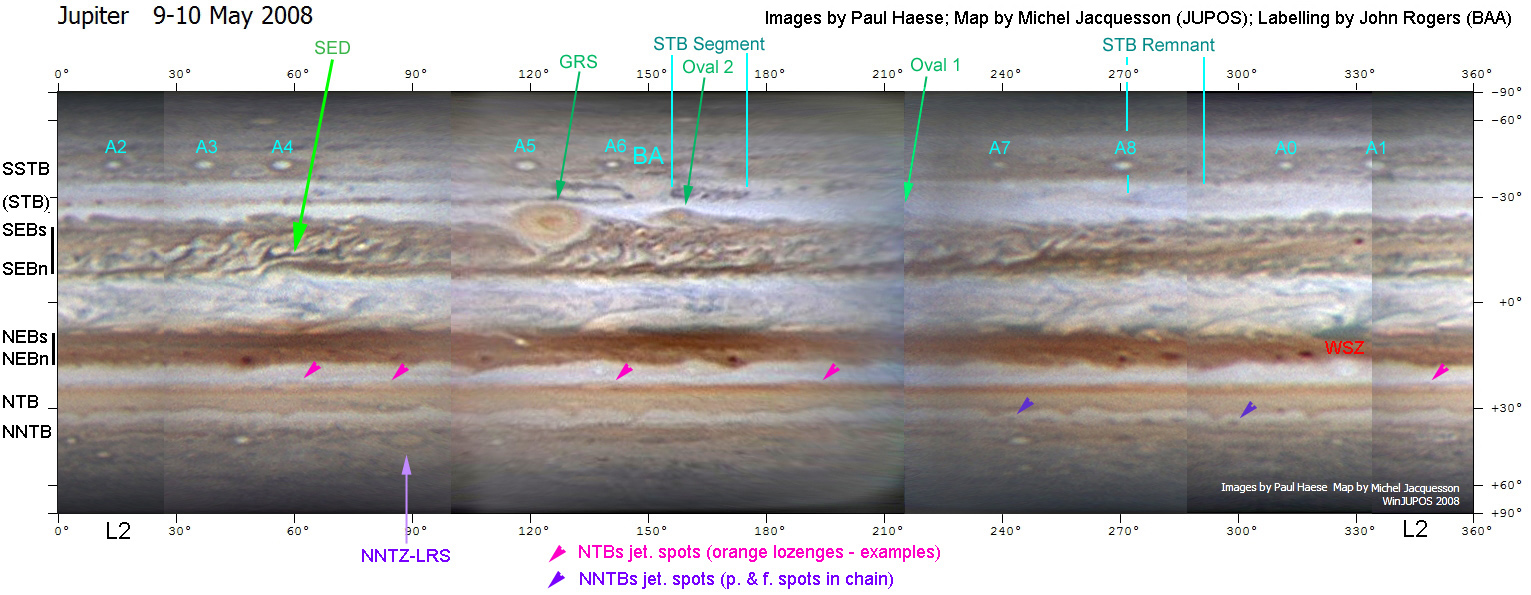
[1] General Comments and Map. May 20th, 2008.
Hi
everyone,
Jupiter in 2008 (1) General comments and map:
The attached map below shows the planet on 2008 May 9-10. Images were taken by
Paul Haese (S. Australia) and compiled into a cylindrical map by Michel
Jacquesson (JUPOS project), and annotated by JHR. Thanks are due to other
observers (especially in Australia and the Philippines) and the other
members of the JUPOS team, who have enabled us to continue our
comprehensive survey of the weather on Jupiter.
This map shows Jupiter during a rapid transition in climate. In 2007 there
were spectacular outbreaks of storms around several of the belts and zones.
Now we can see the aftermath as these disturbances are settling down
towards a more normal state.
The SEB is full of turbulent streaks, as last year's activity has not yet
ended. On its south edge, the vigorous eddying activity of the last 2 years
has been concentrated into two new anticyclonic ovals, and one of these is
a new Red Spot (Oval 2). It is alongside the oval that turned red in 2006
(Oval BA - now paler), and both are approaching encounter with the Great
Red Spot.
The NEB is dark reddish and contains small dark cyclonic ovals called
barges. These are both sequels to turbulent activity last year, and we are
presently watching as some of the new barges collide and merge. The NTB is
a broad orange belt, which reappeared in an extraordinarily energetic
outburst of storms last year. The reddish colour is an aftermath of this
activity. The motion of the orange 'lozenges' on its south edge is enabling
us to follow the deceleration of the jet-stream to its more normal state.
There is also an outbreak of jet-stream spots on the NNTB south edge.
Higher latitudes were not visibly affected by the global upheaval, but
contain interesting sets of long-lived circulations. Oval BA and the STB
segment following it represent one of two large long-lived circulation
complexes in the STB; the other, barely visible but persistent, is the
cyclonic 'STB Remnant'. Further south, in the SSTB, yet another small
anticyclonic white oval has appeared, bringing the total to nine, separated
by low-contrast cyclonic cells. The NNTZ contains another Little Red Spot,
which has existed for several years. Like those in the southern hemisphere
it is an anticyclone topped with high-altitude reddish haze.
A MORE DETAILED INTERIM REPORT WILL FOLLOW SOON.
Happy observing!
John
___________
John
Rogers
BAA
Jupiter Section Director
